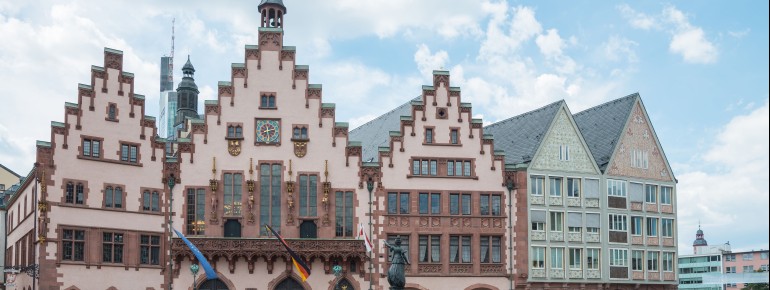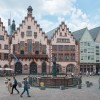Contents
Description
The Römer Rathaus, also known as the "Römer," is a historic building in the heart of Frankfurt's old town at Römerberg. It is one of the city's oldest and most famous landmarks and continues to serve as the seat of the mayor and city administration.
Layout
The Römer Rathaus consists of three interconnected buildings: the Haus Römer, the Schwanenhof, and the Ostzeile. The Haus Römer, the central building in this ensemble, now serves as the administration seat of the city. The Schwanenhof, a half-timbered building from the 17th century, is home to the Frankfurt Historical Museum. The Ostzeile at Römerberg consists of old half-timbered houses located on the eastern side of the square and are used for various purposes, including restaurants and shops.
Exterior Architecture
The Römer building spans a total of three floors and 10,000 square meters. The exterior architecture is marked by the baroque façade of the Haus Römer, decorated with frescoes and distinctive gables. This façade represents the grand architecture of the 18th century. Another notable feature is the famous triple-gabled front, which is engraved with portraits of four German emperors and the city coat of arms. On the renowned balcony of the Römer, not only famous visitors, such as the English Queen, have been received, but football clubs like Eintracht Frankfurt have also celebrated their great victories.
Interior Architecture
Inside the Römer, there is a mix of different architectural styles and eras. The town hall hall in the Römer impresses with its baroque design and is also used as a venue for meetings and events. Impressive halls, such as the Römer and Schwanenhalle, are testimonies of centuries of unchanged architecture. Another highlight is the Kaisersaal, which houses a collection of 52 emperor portraits from the 19th century and incorporates elements from the Middle Ages, Romanticism, and the period of reconstruction.
Historical Information

The Römer Rathaus in Frankfurt has its origins in the 15th century when the original town hall was demolished due to its small size and limited significance. Although the city council had been granted the privilege to build a new town hall as early as 1329, such plans were repeatedly delayed due to other priorities and the financial burdens following the Battle of Kronberg.
Finally, in 1405, the city council acquired the "Römer buildings" and began using them as the town hall. Over time, the building was repeatedly renovated and expanded, with its characteristic façade being designed in the 18th century. The Römer played an important role in political decisions and was even the venue for the coronation celebrations of German emperors. During World War II, it suffered significant damage but was rebuilt after the war. Today, the Römer still serves as the town hall, is a popular venue for celebrations and events, and continues to be the seat of the mayor.
How to get there
By car: Parking spaces near the Römer are limited. Therefore, it is recommended to park your car in parking garages or Park-and-Ride facilities.
By train: Frankfurt has one of the largest train stations in Europe, Frankfurt Hauptbahnhof. You can easily travel to Frankfurt by train from many German cities. From the main train station, you can take the subway or walk (about 20 minutes) to the Römer.
By plane: From Frankfurt Airport, you can take the S-Bahn, a taxi, or a shuttle service into downtown Frankfurt.




